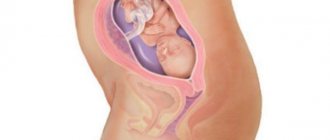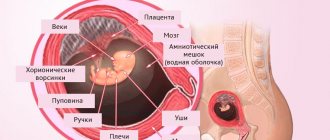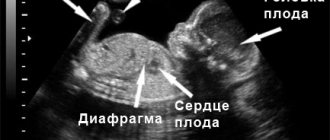What is amniocentesis?
It was for diagnostic purposes that amniocentesis was first performed in 1966.
A decade earlier, they were able to determine the cells of the fetus and its gender in the amniotic fluid.
Until this time, puncture of the amniotic sac was used back in the century before last as a method of treating polyhydramnios, as well as for the purpose of killing the fetus at a later stage.
The essence of the “Amniocentesis” method is to take amniotic fluid (amnion) to determine the karyotype of the fetus and confirm the expected diagnoses, namely:
- Down syndrome;
- Patau syndrome;
- Edwards syndrome;
- diseases caused by pathology of the development of the neural tube of the fetus;
- cystic fibrosis;
- sickle cell anemia.
Amniocentesis is also performed to identify complications of the current pregnancy, including intrauterine infection and fetal hypoxia.
In some cases, when early delivery is necessary, amniocentesis is used to assess the development of the baby's lungs, as well as for amnioreduction in case of polyhydramnios, and for carrying out prenatal treatment measures for the fetus.
Invasive diagnostic methods, including amniocentesis, have been widely used since ultrasound guidance was introduced into obstetric practice.
Until this time, punctures were carried out blindly, which, of course, did not guarantee the safety of manipulation with the needle for the expectant mother and baby.
When is amniocentesis performed?
Amniocentesis analysis can technically be performed at any stage of pregnancy, however, early amniocentesis (before the 15th week) is rarely performed and for special indications due to the small amount of amniotic fluid at that time.
Amniocentesis, in order to make a diagnosis of genetic diseases of the fetus, is carried out at 16–24 weeks of pregnancy (optimally at 16–20 weeks), so that parents have the opportunity to make a decision about the fate of the pregnancy.
Advantages and disadvantages
Amniocentesis during pregnancy is a fairly common procedure in which candidates for testing are pregnant women over 35 years of age, or those who have had a screening test of maternal serum and identified chromosomal abnormalities.
There are certain risks associated with the procedure, so some women who clearly know that they would not want to terminate their pregnancy choose not to take the test.
Pros of amniocentesis:
- Screening can be used early in pregnancy to detect genetic defects in the fetus due to chromosomal disorders (Down syndrome), sex-linked defects (hemophilia), neural tube defects (such as spina bifida), inborn errors of metabolism (cystic fibrosis), and enzyme deficiency, for example Tay-Sachs disease.
- Amniotic fluid testing helps assess the maturity of the fetal pulmonary system by determining the lecithin/sphingomyelin (L/S) ratio, which measures surfactant levels in the fetal lung.
- Amniocentesis is used therapeutically to relieve hydramniosis (excessive amniotic fluid) and for intrauterine transfusion.
Disadvantages of the procedure:
- Complications are rare, but some can be serious. The placenta, fetus, or umbilical cord may be accidentally punctured, causing injury. Trauma, ranging from minor scratches on parts of the fetus to intrauterine hemorrhage, leads to distress and fetal death.
- Perforation of the placenta promotes hemorrhage from the fetal circulation, which can lead to fetal anemia or increased sensitization in the Rh-negative mother.
- Leakage of amniotic fluid through the vagina can increase the baby's risk of orthopedic problems, so the procedure is not recommended before the 15th week of pregnancy.
- Amniocentesis can cause the baby's blood to mix with the mother's blood. If the blood types do not match, then Rh immunoglobulin is prescribed to prevent the mother's blood from generating antibodies against the baby's blood cells.
Other dangers include induction of preterm labor and intra-amniotic infections.
Every woman, before agreeing to a test, must take into account the possible consequences and weigh the pros and cons. In addition, the test result cannot guarantee the birth of an absolutely healthy child; it only excludes some pathologies.
Its accuracy is about 99.4%. Therefore, every pregnant woman should consult a geneticist and only then make a final decision.
Indications and contraindications: to do or not?
Amniocentesis, as a procedure that involves penetration into the body of a pregnant woman, and, therefore, carries certain risks for the condition of the future mother and fetus, should be performed exclusively for medical reasons and in cases where the risk from the procedure does not exceed the risks from the development of postoperative complications .
A woman should be recommended to undergo amniocentesis for diagnostic purposes if:
- there are age-related risks of fetal development pathologies, that is, the age of the expectant mother is more than 35 years;
- the results of screening examinations showed a disappointing prognosis for the development of incurable congenital diseases in the fetus;
- the parents of the unborn baby may be carriers of hereditary diseases or diseases caused by chromosomal abnormalities;
- During previous pregnancies, the woman carried a fetus with developmental defects.
In addition, invasive intervention may be necessary during pregnancy if:
- a puncture is necessary for medical measures (intrauterine therapy, surgery) for certain types of complicated pregnancy (polyhydramnios, intrauterine infection, etc.);
- For medical reasons, it is necessary to terminate the pregnancy in the later stages.
Contraindications to amniocentesis, due to the high risks of subsequent complications for the condition of the pregnant woman and the fetus, are:
- infectious diseases in the acute stage, fever;
- large myomatous nodes;
- threat of spontaneous abortion.
Even if the expectant mother, according to some selection criteria, is among those who are indicated for amniocentesis, she will first have to consult a geneticist who, in each individual case, evaluates the need for the procedure, weighing all possible risks.
How long does it take to do the procedure?
The need for amniocentesis and the timing of its implementation are determined by the doctor who monitors the course of the entire perinatal period.
It is usually prescribed after 16 weeks. At this stage, it is already possible to determine the child’s chromosome set.
However, there are 2 more periods when amniocentesis can be prescribed:
- 20-25 weeks - at this period there are several indications for amniocentesis. It is carried out if it is necessary to terminate a pregnancy for medical reasons. The second case when amniocentesis is necessary at this particular period is to identify certain fetal diseases that cannot be determined earlier.
- 3rd trimester of pregnancy - during this period, amniocentesis is prescribed if premature delivery is necessary.
How to prepare for the procedure
If there are medical indications for a future woman in labor, amniocentesis can be carried out at the expense of social insurance, if there is such a technical and technological possibility in a laboratory serving pregnant women in the areas of antenatal clinic.
And, as before any surgical intervention, the expectant mother will have to provide medical information upon request. staff analysis results of the “small preoperative collection”:
- clinical blood and urine test (not older than 1 month);
- Rh blood group analysis;
- markers of infectious diseases in the blood: HIV, syphilis, hepatitis B, C (not more than 3 months old).
Some institutions may also request ultrasound results.
The most difficult part of preparing for amniocentesis for a woman, apparently, is moral readiness. And this is important. Often, the safety of the procedure and the physical condition of the patient after it depend on the woman’s calmness.
As a rule, no other preparations are required. Perhaps, with early diagnosis, the expectant mother will be asked to come with a full bladder. With late amniocentesis, on the contrary, the patient should empty her bladder and bowels before the procedure.
For hygienic reasons, a woman should take a change of underwear with her, since the puncture site is generously treated with antiseptic liquid, which, of course, will saturate the clothes.
Mothers with negative Rh factor blood need to ensure that after the procedure they receive an injection of anti-Rhesus immunoglobulin in order to avoid consequences due to Rh conflict.
An injection of immunoglobulin is given only if the fetal blood is Rh positive.
Immediately before the operation, the woman will have to express her consent in writing to undergo amniocentesis, and also confirm that she is familiar with the possible risks.
Contraindications
The minimally invasive diagnostic procedure is not suitable for everyone. It is prescribed only for reasons of pregnancy safety.
There is a certain group of contraindications:
- infectious diseases (HIV, AIDS, hepatitis) in a woman, since they can be transmitted to the child during screening;
- uterine fibroids;
- febrile state of a pregnant woman;
- risk of miscarriage.
If there is a suspicion of poor blood clotting in a pregnant woman, then medications are used to stop the bleeding.
How to carry out the procedure
Depending on the rules of the procedure in a particular medical facility. institution, the woman’s early arrival is required for preoperative preparation: a preliminary examination of the pregnant woman, an ultrasound scan to assess her condition and the condition of the fetus, and the absence of contraindications for invasive intervention.
Under the strict control of an ultrasonic sensor, the puncture site is selected: as far as possible from the fetus and umbilical cord arteries, preferably without affecting the placenta.
If it is impossible to obtain the required amount of material for analysis extraplacentally (as in the case of localization of the placenta along the anterior wall of the uterus), then an area of the least thickness is selected to puncture the placenta.
The site of the intended puncture is treated with an antiseptic, sometimes additionally with a local anesthetic. In general, the operation is considered painless.
Most women who have undergone amniocentesis confirm that the sensations during the doctor’s manipulations can hardly be called painful, rather a slight tugging, and the pain of the puncture itself is comparable to the sensations during a regular injection.
The puncture is made with a fairly thin puncture needle, in most cases, penetrating into the amniotic sac through the peritoneum and myometrial walls.
Transvaginal or transcervical amniocentesis, as a rule, is not performed in the second trimester due to the higher likelihood of developing postoperative complications during pregnancy.
After the needle has entered the amniotic sac, about 20 ml is taken through its hole. amniotic fluid, which contains embryonic cells. Moreover, the first 1 - 2 ml. fluid is neglected because it may contain cells from the mother.
The resulting material is sent to the laboratory for research, depending on the purposes of amniocentesis.
If it was not possible to obtain the required amount of liquid the first time, the puncture is repeated.
After removing the needle, doctors monitor changes in the well-being of the pregnant woman and fetus for some time using ultrasound. It is even possible to place the patient in a hospital.
If the outcome of the operation is successful and no negative consequences are expected from its implementation, the woman is discharged with a sick leave certificate upon request.
For several days after amniocentesis, the expectant mother is prescribed a gentle regimen. If any alarming symptoms appear: leakage of amniotic fluid, discomfort at the puncture site, abdominal pain, increased body temperature, etc., you must consult a doctor immediately.
Amniocentesis for multiple pregnancies
For cases with multiple pregnancies, both single and double needle insertion through 1 puncture may be required.
In the first case, the needle enters one of the amniotic cavities and, after taking fluid from it, the needle is advanced to puncture the septum between the cavities and take fluid from the second bladder. In the second case, access to the fetal bladder occurs with different needles through multiple punctures in the woman’s abdominal cavity.
In order to avoid repeated sampling of amniotic fluid from the same amniotic sac, the amniotic fluid of one of the twins is tinted with a safe dye.
Amniocentesis - a possible risk during the test
In most cases, the amniocentesis procedure is completely safe. The reaction of women to the results of a test that may show that the fetus has a congenital disorder, an inherited disease, or Down syndrome is more unpredictable than the possible risks of the procedure. But there are still certain risks:
- If an inexperienced specialist undertakes the procedure, he may prick the mother or fetus with a needle. To reduce this risk, ultrasound is used to accurately guide the puncture needle. It happens that during the procedure the placenta is punctured, but it recovers quickly.
- There is a risk of infection in the amniotic sac - this happens in 1 in 1000 cases.
- Miscarriages. According to statistics, when amniocentesis is performed by experienced specialists, the risk of spontaneous abortion is 1 in 400 cases. Sometimes miscarriages after the procedure are not related to the procedure itself; the problem may lie in the course of the pregnancy or in the fetus itself.
- If the procedure is performed before the 15th week, there is a risk that the unborn child will develop clubfoot.
- There is a risk that during amniocentesis the mother's blood will mix with the fetus' blood. This fact can only cause concern when the mother and fetus have different Rh factors (the mother has a negative Rh factor) and there is a possibility of Rh sensitization, that is, increased sensitivity of the body to the effects of various factors. To avoid such a risk, a woman is given a special vaccine after the procedure that prevents this risk.
When will the analysis results be ready?
In the standard course of examination of fetal cells, the results of amniocentesis become known 14 to 28 days after the procedure.
Readiness times depend on the test method and the rate of fetal cell division.
The fact is that the amniotic fluid obtained during collection contains a very small number of fetal cells, which is insufficient for full testing.
Therefore, for a detailed analysis of the presence of possible anomalies in the fetus, preliminary cultivation of its cells selected from the amniotic fluid is required for 2 to 4 weeks in order to obtain the required number.
If, after this time, active cell division has not been achieved, or the material has been lost for some reason, then the woman will have to undergo a repeat amniocentesis.
If honey The institution where the woman undergoes amniocentesis has a laboratory technically equipped to conduct FISH tests, then results for some chromosomal pathologies - trisomies - can be obtained within 24 hours.
Conducting an accelerated study is more complex and therefore more expensive. It is usually carried out for an additional fee.
Aftercare treatments
After surgical procedures, a woman needs support:
- Physical care. During and immediately after the sampling procedure, a woman may experience dizziness, nausea, rapid heartbeat, and seizures. After the procedure, the woman goes home, where she needs to rest for 24 hours, having previously received instructions in case of complications.
- What is contraindicated:
- lift weights throughout the day;
- exercise for 24 hours;
- air travel within 72 hours.
- Emotional withdrawal. After the surgery is completed safely, the anxiety of waiting for test results can negatively impact a woman's well-being. At this point, she must receive emotional support from family and friends. Professional counseling may be necessary, especially if a fetal defect is detected.
As a rule, women after the procedure can begin their duties at work within 1 day.
Where can I get amniocentesis?
If the expectant mother has the opportunity to choose honey. institutions to undergo the procedure, even at their own expense, then you should focus primarily on the reviews of your predecessors about the professionalism of the doctors performing the surgical intervention, on the statistics of negative consequences caused by punctures and manipulations with the needle in this clinic, etc.
To undergo amniocentesis in Moscow, expectant mothers most often turn to the following medical institutions:
| Name of honey institutions | Cost of the procedure (RUB) |
| Perinatal Medical Center (on Sevastopolskaya) | 14850 |
| KB MSMU im. Sechenov | 5000 |
| NTSAGiP im. V. I. Kulakova (on Oparina, 4) | 6000 |
| Clinic “Mother and Child” (Dilamed) (m. Sokol) | 6800 |
| Center for Fetal Medicine (Prenatal Genetic Center at Chistye Prudy) | 8000 |
The price of the procedure may include, in addition to non-operative services provided by the clinic to its patients, also an accelerated cell analysis by the “direct” method (FISH test) with the provision of preliminary results.
Results of amniocentesis and further tactics
The accuracy of studying amniotic fluid and diagnosing congenital and hereditary diseases reaches 99%. Once the amniotic fluid is obtained, it is taken to the laboratory and the fetal cells are isolated from it. These cells are planted on nutrient media to increase their number. Cytogenetic analysis of normal waters shows the content of 23 pairs of normal chromosomes, without structural abnormalities.
- By the number and quality of chromosomes, the presence of chromosomal diseases such as Down syndrome, Edwards syndrome, and Patau syndrome can be determined.
- Identify/confirm neural tube defects: anencephaly and spina bifida.
- Cytogenetic analysis of amniotic fluid allows us to identify hereditary diseases (cystic fibrosis, sickle cell anemia), which are not normally present.
- Also, examination of the fluid reveals intrauterine infection (herpes, rubella).
- Allows you to determine the group and Rh factor of the fetus and sex, which is important for predicting some hereditary diseases linked to the Y chromosome with the X chromosome (for example, hemophilia).
- Determine the severity of fetal hemolytic disease and decide on further pregnancy management tactics.
In addition, in some cases (for example, severe gestosis that cannot be treated), it is necessary to identify the degree of maturation of the unborn child’s lungs and resolve the issue of premature birth. The degree of lung maturation is assessed based on the ratio of lecithin and sphingomyelin (biochemical analysis of water):
- L/S is 2/1 – full maturity of the lungs;
- L/S is 1.5 – 1.9/1 – in half of the cases the development of respiratory distress syndrome is possible;
- L/S is 1.5/1 - in 73% the development of respiratory distress syndrome cannot be excluded.
If any deviations are identified, doctors in consultation decide on further tactics for pregnancy management.
If gross fetal defects incompatible with life or chromosomal and hereditary diseases are detected, the woman is offered to terminate the pregnancy. If she refuses to terminate, she is placed in a high-risk group and a specialized maternity hospital is selected for the delivery of women in labor with a similar pathology.
If hemolytic disease of the fetus or intrauterine infection is detected, appropriate therapy is prescribed, and the optimal timing for delivery is determined.
In some cases, when abnormalities in the development of the fetus are identified that do not threaten its life, tactics for treating the fetus are selected with the possible implementation of fetotherapy or fetosurgery.
Important! All materials are for reference purposes only and are in no way an alternative to face-to-face consultation with a specialist.
This site uses cookies to identify site visitors: Google analytics, Yandex metrics, Google Adsense. If this is unacceptable to you, please open this page in anonymous mode.
Reliability of results
The reliability of amniocentesis, according to doctors, is close to 100%, or more precisely 99.5%. This applies to tests for those genetic abnormalities that the task is to identify.
The remaining 0.5% for errors includes cases in which the following occurs:
- mixing of maternal cells with fetal cells during amniotic fluid collection;
- mosaicism occurs;
- when cells undergo mutation during their cultivation;
- in case of loss of fetal cellular material after collection;
- errors due to the “human factor”.
It is, of course, impossible to diagnose all possible genetic diseases in the fetus. The analysis is carried out for those pathologies that occur most often (by nationality) and/or that are suspected based on preliminary non-invasive studies specifically in this case. Amniocentesis will not show non-genetic defects.
How long will the results last?
If the amniocentesis results are normal, the baby does not have any genetic or chromosomal abnormalities. In the case of mature amniocentesis, these test results ensure that the baby is ready for birth with a high probability of survival.
Abnormal results may mean there is a genetic problem or chromosomal abnormality. But this does not mean 100% probability. Additional diagnostic tests should be done to gain more information.
If a woman is unclear what the results mean, doctors can help gather the information she needs to decide about next steps.
Are there any complications?
Amniocentesis, compared to other invasive research methods, is considered the safest procedure.
The probability of developing complications after it is less than 1%, according to medical statistics.
Of course, the density of negative consequences after amniocentesis in relation to the total number of operations performed for each practicing doctor depends on his experience, the professionalism of assistants and the quality of auxiliary equipment.
In addition, the risk of complications after the intervention also depends on the woman’s health status and the course of pregnancy.
The consequences of amniocentesis can be:
- leakage of amniotic fluid, bleeding (which requires the woman to be admitted to a hospital and undergo conservation therapy);
- intrauterine infection of the woman and fetus;
- injury to the fetus, umbilical cord arteries;
- loss of the fetus due to spontaneous abortion.
Miscarriage or premature birth are considered the main potential hazards of amniocentesis.
However, we should not forget that according to statistics, the probability of spontaneous abortion even with a normal pregnancy is about 1.5%. Therefore, a disastrous pregnancy outcome after invasive intervention may be a coincidence and not a consequence of amniocentesis.
Technique
The procedure begins with an ultrasound, during which a pocket of amniotic fluid is identified, free from umbilical cord loops and the edges of the placenta. The entire manipulation is also carried out under ultrasound control. Amniocentesis is often performed without anesthesia, but local anesthesia with a 0.5% novocaine solution is also possible. A selected area of the skin of the anterior abdominal wall is treated with an alcohol solution of an antiseptic, after which the doctor pierces the skin, subcutaneous fat layer and the wall of the uterus with a puncture needle, which is attached to a syringe, and then sucks out the amniotic fluid.
The first 0.5 ml of amniotic fluid is unsuitable for research, since it may contain the woman’s cells, so it is poured out. The next fluid intake is 15-20 ml, after which the needle is removed and the puncture site is re-treated with an antiseptic. The woman is asked to rest for an hour. The whole procedure takes 2-3 minutes.
Amniocentesis. Interview with a doctor
Yesterday we published an article about personal experience of undergoing the amniocentesis procedure, and today there will be an interview with a doctor of the highest qualification category of medicine, Ekaterina Alexandrovna Lukyanova. The main area of activity of Ekaterina Alexandrovna is ultrasound diagnostics, she conducts expert ultrasound examinations of the fetus at any stage of pregnancy in 2D/3D/4D modes, and has additional education in organizing prenatal diagnostics in the 1st trimester.
What is amnicentesis?
– Amniocentesis is a diagnostic invasive procedure that involves removing a small amount of amniotic fluid for analysis.
What does this analysis reveal, why is it taken?
– Most often, when performing amniocentesis, we are interested in the karyotype of the fetus, i.e. set of chromosomes. Down syndrome is a chromosomal pathology, an additional 21 chromosome. The risk of having a child with this particular pathology increases with a woman’s age. Although at a young age there is a risk of having a child with Down syndrome. After 15 weeks of pregnancy, the amniotic fluid contains a sufficient amount of material - fetal cells - for analysis. The reliability of this study is the highest among existing prenatal diagnostic methods for determining the number and structure of fetal chromosomes. Only with the help of an invasive procedure (there is also a CVS and cordocentesis) can the karyotype of the fetus be assessed. A normal karyotype indicates chromosomal well-being in the baby.
Several decades ago, it was noticed that the older a woman is, the more often she gives birth to children with Down syndrome or some other chromosomal pathology. The age of the father plays a lesser role, since sperm are constantly renewed, and 3 months pass from the moment of maturation to readiness for fertilization. A girl is born with a certain number of eggs, and they are exposed to all negative factors: past illnesses, medications, alcohol, smoking, etc. Therefore, amniocentesis was initially performed only by age - all women over 35 years of age. The information content of this approach was low, so other approaches were developed. The first ultrasound marker was the thickness of the cervical fold (nuchal translucency, TVP, NT). The use of this marker, related to the coccygeal-parietal size of the fetus and the woman’s age, made it possible, using a computer program, to identify a high-risk group, and it was to this group of pregnant women that invasive diagnostics could be offered. The information content of this approach was 70%. This means that out of 10 fetuses with Down syndrome who were examined by ultrasound at 12 weeks and their risk was calculated, only 7 would be at risk.
Now they take blood biochemistry from pregnant women, what kind of analysis is it, and what is determined in it?
— Over time, new markers appeared, biochemical ones, the same biochemical screening. These include the free beta-hCG subunit and the PAPP-A protein. During a normal pregnancy, with increasing gestational age, the concentration of beta-hCG in the blood decreases; during pregnancy with a chromosomal pathology, primarily with Down syndrome, such a drop in the concentration of beta-hCG is not observed. Protein PAPP-A is the opposite: its concentration in the blood during a normal pregnancy increases with the period of pregnancy, but when the fetus has a chromosomal pathology, this does not happen in proportion to the period. These biochemical markers were added to the ultrasound ones. This is what is called combined screening. Its reliability is about 90%. Therefore, women over 35 years of age are still recommended to undergo the procedure of collecting amniotic fluid.
What other indications are there for amniocentesis?
— In addition to those already mentioned, there are other indications. For example, during an ultrasound scan, so-called soft markers of chromosomal pathology were identified in the fetus, i.e. At 12 weeks, everything is fine on ultrasound, then some other markers are revealed that are not developmental defects, but they are more common in fetuses with chromosomal abnormalities. Also, if any developmental defects are detected in the fetus, a number of these defects are associated with chromosomal pathology. For example, when we see a congenital heart defect, such as the atrioventricular canal, on an ultrasound, we understand that the child will have a high risk of Down syndrome. Therefore, if any fetal malformation is detected, consultation with a geneticist is necessary. The next indication is the presence of chromosomal rearrangements in one of the parents. There are situations when one of the parents has a restructuring, but it is balanced and does not manifest itself in any way, and his future children may also simply be carriers, or this restructuring may become unbalanced, and the disease will manifest itself.
How do you know that you are the bearer of such a restructuring?
— All couples who have had 2 or more miscarriages or infertility should undergo karyotyping as part of the examination. To do this, blood is taken from a vein.
What about genetic diseases?
- Yes, if some gene diseases are known in the family, and there is a diagnosis for these diseases, then amniocentesis is also performed, but it is not the karyotype that is studied, but whether the fetus has a pathological gene for a certain disease, for example, hemophilia.
Is it just us who have such indications for amniocentesis?
— No, in all developed countries. There are slight differences and approaches depending on the organization of medicine itself (free, paid, insurance). For example, the attitude towards the patient’s age over 35 years. When calculating the risk when conducting combined screening, age is taken into account, and if a woman over 35 years of age is not in the risk group, then her age-related risk has decreased and she is not offered invasive diagnostics. This path is followed in Russia, for example, and in a number of European countries. In our country, a pregnant woman over 35, even if she is not in the risk group, is offered amniocentesis, and the older the woman, the more insistently she is offered. Because Screening methods do not provide a 100% guarantee. And here the decision is made by the family individually, taking into account all the data.
How is this regulated by law?
— Indications for invasive diagnostics are regulated by Decree of the Ministry of Health No. 26 of March 28, 2007.
Why does it take so long to wait for results, about four weeks, this is very emotionally difficult for a pregnant woman. What determines these deadlines?
— The fact is that this is a complex analysis, the analysis technique itself is not fast. Cell culture must be grown, stained, fixed, etc. and then a very complex karyotype assessment. Chromosomes are counted, and each is assessed not in one cell, but in several dozen. And if a pathology is detected, then the number of cells for assessing the chromosome set increases. The cytogenetic laboratory of the Republican Scientific and Practical Center “Mother and Child” does this analysis for almost the entire country. No one deliberately delays the deadlines; doctors understand perfectly well that pregnant women are waiting and worried, and that they must adhere to the deadlines at which it is possible to terminate the pregnancy if a chromosomal pathology is detected.
Please tell us about the risk groups, based on what they are considered?
— We have a risk group threshold of 1:360; if the number is lower, it means the risk of having a child with a chromosomal abnormality is increased. However, when you get a result in the range of 1:360-1:1000, it becomes exciting. It doesn’t seem like a risk group, but very close. Then additional markers are used in the first trimester of pregnancy: nasal bone, assessment of regurgitation on the tricuspid heart valve and blood flow in the ductus venosus. If an ultrasound reveals these defects, then the pregnant woman may be classified as a high-risk group and be offered invasive diagnostics. These markers are not as informative as the neck crease, but they increase the risk.
What are the contraindications for amniocentesis?
— A pronounced threat of miscarriage, infectious diseases, with hepatitis and HIV infection, the risk of infection of the fetus increases, during amniocentesis, large myomatous nodes that interfere with the procedure itself.
Let's discuss the risks of amniocentesis. There is a lot of controversy about the procedure.
— Like any invasive procedure, amniocentesis can be accompanied by complications. The risk of these complications is small and amounts to 0.5-1%. The pregnant woman’s fears for the baby are much greater, that “he will be pricked with a needle” and from not knowing how everything happens. The procedure itself is done under ultrasound control; first, the baby’s heartbeat is checked, the baby’s position is assessed, where the placenta is located, and a pocket of free water is selected for puncture. When the doctor feels the puncture site with his finger, the baby, a smart little man, groups himself and moves away. After the puncture, the fetal heartbeat is again checked. The procedure is very fast. The time from the moment a woman enters the office and leaves it is often no more than 10-15 minutes. There are world statistics that if a doctor performs about 200 amniocenteses a year, then the risk of complications is no more than this figure. Our doctors are highly qualified and trustworthy. The most serious complication is termination of pregnancy. Over the 5 years of my practice of performing this procedure, this happened once; chromosomal abnormalities were discovered in the fetus. There is a minimal risk of amniotic fluid leakage, but I have not encountered this. There is a possibility of increased tone, but this is rather a psychological moment. It happened that the water was already infected when taken - brown, green, but this no longer applies to complications of amniocentasis; by this time the pregnant woman already had an infection.
Is there already an alternative to the invasive method?
— Yes, non-invasive prenatal test (NIPT). This test involves examining fetal DNA in the mother's blood. Unlike amnicentesis, this is still not an absolute conclusion, it is a screening test. But its information content and reliability are significantly higher than combined screening. This analysis can be performed as early as the 9th week of pregnancy. In women with increased body weight, the concentration of fetal DNA in the blood is lower, and this should be taken into account in the early stages. Previously, when this test was carried out, the fetal DNA fraction was not isolated, the total DNA was counted, and this was not always reliable, so there was a skeptical attitude towards this test. Now it is possible to isolate the DNA of her child separately in a mother’s blood. There are several options for conducting the test itself and counting nucleotide fractions. There is a DOT test, there is Panorama, there is Veracity. These are laboratory options for one type of non-invasive prenatal test. Techniques continue to evolve. All over the world it is believed that this research has the future and its reliability is growing with each new development. This test is not carried out in Belarus; it is a very complex test, high-tech, more complicated than amniocentesis. While this test is quite expensive, about $500, not every family can afford it. Another disadvantage is that this method, unlike amniocentesis, diagnoses only 5 chromosomal abnormalities (including Down syndrome). And the big advantages are its absolute safety for mother and fetus and quick results in 7-10 days. We only take blood and send it to very powerful genetic laboratories in Moscow or even the USA, California. A number of countries are moving to using NIPT as a screening test to form a risk group instead of combined screening.











